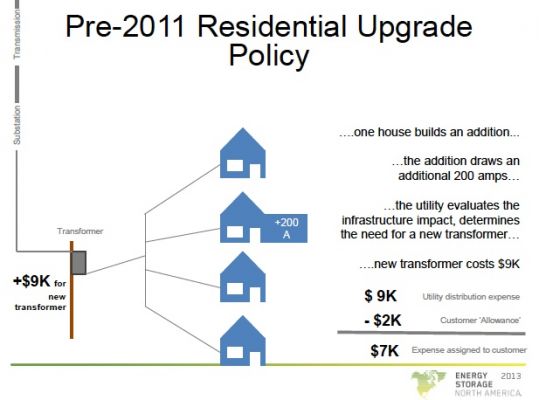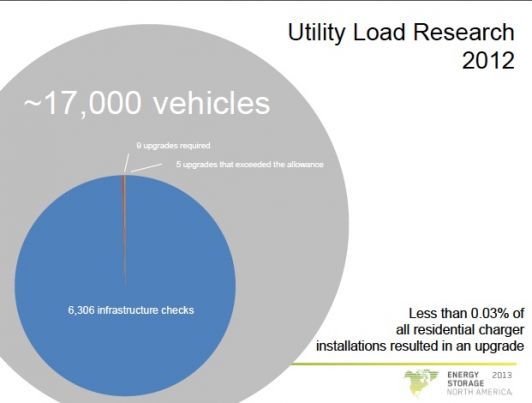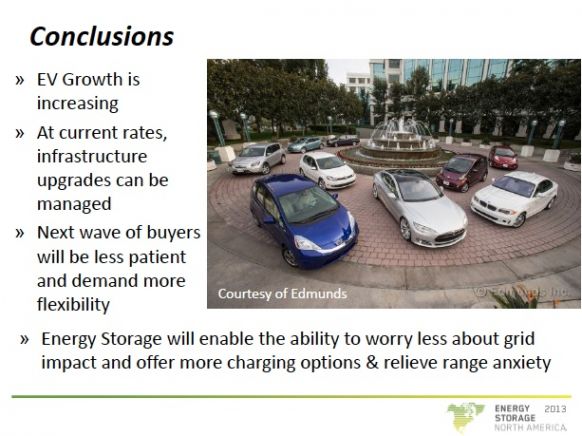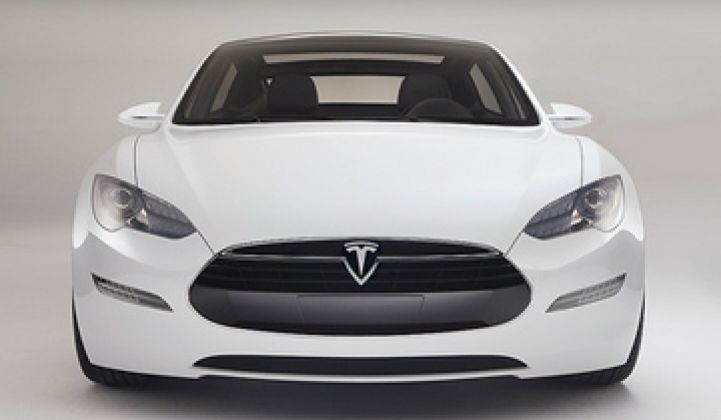Doug Staker, the VP of Business Development at Demand Energy, would like to own a Tesla Model S. Unfortunately, he has two children in college and at least one responsible adult household member (his wife) with little desire for the car. (Demand Energy builds integrated energy storage systems for behind-the-meter energy optimization and emergency backup in the enterprise.)
Staker led a conversation with CPUC Sr. Energy Analyst Adam Langton about the challenges for electric vehicle charging on the distribution grid at last week's ESNA energy storage event in San Jose, Ca.
With regards to electric vehicles (EVs), Langton said, "This is a load we're trying to promote."
Langton noted that EVs and distribution upgrades are part of California's Zero Emission Vehicle action plan. With some forecasts putting 1.5 million EVs on the roads by 2025, Langton suggests that if all of those EVs charged at one time, "We'd have a big problem meeting that load."
If each vehicle requires 10 kilowatts, that results in a total of 15,000 megawatts.
So how does the utility make sure the distribution grid can withstand this increase in usage? Are there ways that load management or energy storage can defer distribution upgrades? How can upgrades be paid for in an equitable way? What is the PUC doing about it?
Langton notes that there is one transformer for every four to seven homes in the U.S. -- a ratio sized to the anticipated load for those neighborhood homes.
Local distribution is a shared resource, along with new transformers and drop lines. So far, according to Langton, "We've used the allowance system. You're supposed to let the utility know that you have an additional load." The utility then checks to see if the transformer has capacity and if an upgrade is needed. If it does, the customer pays for part of the upgrade, while a small sum is "socialized."
Say a homeowner builds an addition that draws 200 amps and requires a bigger transformer. In this case, most of the cost would be borne by the homeowner. The $9,000 transformer would cost the homeowner $7,000, with the additional $2,000 "socialized."
Here's another scenario: There are four homes on a single transformer. Home #1 purchases an EV. There's plenty of capacity on the line and no charge from the utility. Home #2 purchases an EV, but there's still extra capacity on the line. But Home #3 cannot charge its EV without an expensive upgrade. Obviously, that's less than fair.

So the 2011 Commission added "new and permanent load" language, looking to treat distribution upgrades as a "common facility" to "socialize the cost of these upgrades." The CPUC asked the utilities to conduct load research to better understand the impact of EVs, and the utilities started collecting data on EVs in their territories.

It turns out that there were 6,306 infrastructure checks in 2012 out of approximately 17,000 EVs in the territory. Fewer than nine upgrades (or less than 0.03 percent) were needed for the total 6,306 new EVs reported. Of these nine upgrades, five would have exceeded the allowance, according to Langton.
The CPUC analyst notes that the commission does expect "more clustering on particular transformers." (See Manhattan, Berkeley, Palo Alto, Atherton, etc.) And the CPUC suggests that it needs more time to understand the impact of PEVs on the distribution grid. Proposals include a continued common facility treatment until July 2016 and limiting the common facility treatment to chargers of less than 7 kilowatts. (That was removed because consumers want higher charging rates.) Other proposed cost-assignment strategies include socializing the cost up to a maximum size, a service connection upgrade fee (suggested by DRA), a separate allowance (suggested by TURN) and other PEV tariffs.
Doug Staker currently drives a white Aztek, but for the sake of the panel discussion, he pretended that he's a Tesla Model S owner. Staker notes that the top three EVs are the Leaf, Volt and Tesla S, all about equally split in average sales per month. He said that the Leaf, with its 24 kilowatt-hour battery and 75-mile range, is for the "real EV evangelist" who is willing to deal with range issues.
Staker said, "I need 300 miles of [imaginary] range," to go along with his imaginary garage and his imaginary supportive family.
He notes that the Tesla can charge up to 10 kilowatts, and we are seeing "higher and higher charging rates." Staker said, "Just when we have [charge rate] understood -- it doubles." He added, "The electric car is here to stay," and pointed out that early PEV growth rate has exceeded early hybrid vehicle growth rate.
Staker cautioned, "Our friends in the utility business are getting more and more nervous."
He added, "Current EV owners are brave and bold" and they're the early adopters. Staker is "an enthusiast" -- and "what keeps the utility up at night is the wave of enthusiasts" about to become EV owners.
Faster adoption will require flexibility in charging, said Staker, adding, "People want to charge when they want to and need to." Staker points to a Tesla charging bay where four cars supercharging at 120 kilowatts each produce 480 kilowatts of load with only 20 kilowatts of solar PV on the roof.

Staker's company, Demand Energy, equipped Barclay Tower, a luxury residential apartment tower in Manhattan, with its energy storage system and integrated the system with the region's power provider, Consolidated Edison. According to Staker, urban EV charging "scares the hell out of [ConEd]."
The high-net-worth individuals and potential Tesla drivers living in the 58-story Barclay Tower share a 550-kilowatt common space load along with parking for 200 vehicles. The building owners installed a 225-kilowatt/2-megawatt-hour system in the basement after positive trial results with demand response and building grid stability.
The system charges the batteries from midnight to 5 a.m. The building comes to life at 7 a.m., and over the next sixteen hours, the storage system trims a series of demand spikes. "The building load is erratic, and the idea is to do demand-shifting," said Staker in an earlier interview.
Now imagine fast-charging Teslas and Zipcars making demands on this building where five Tesla Sedans charging simultaneously "could swing load by 100 kilowatts," according to Staker.
"Now I know why ConEd is a little worried at night," said Staker.
John Boesel of Calstart told Greentech Media, "The EV's disruption of the grid is the biggest non-issue." He suggested that, in California, transformers and distribution grids will be upgraded as per the utility's normal maintenance schedule and that the matter is overblown.
The experiment of what happens to an electrical grid subject to high levels of EV charging has begun. It places a burden on the grid equipment which was not engineered to function in this manner (with transformers not permitted to cool at night, etc.) and also pushes against regulatory and behavioral headwinds.
But it also opens up room for innovation and disruption at this grid-edge intersection of EVs, batteries, solar and IT.




